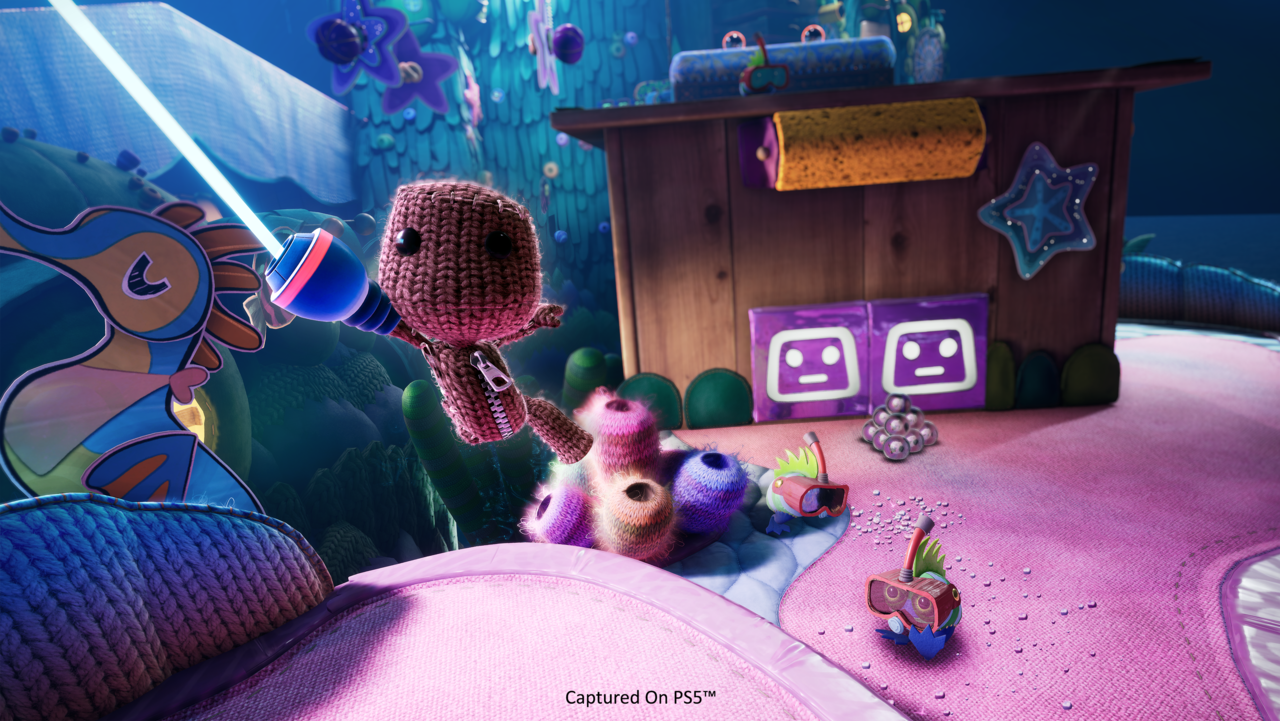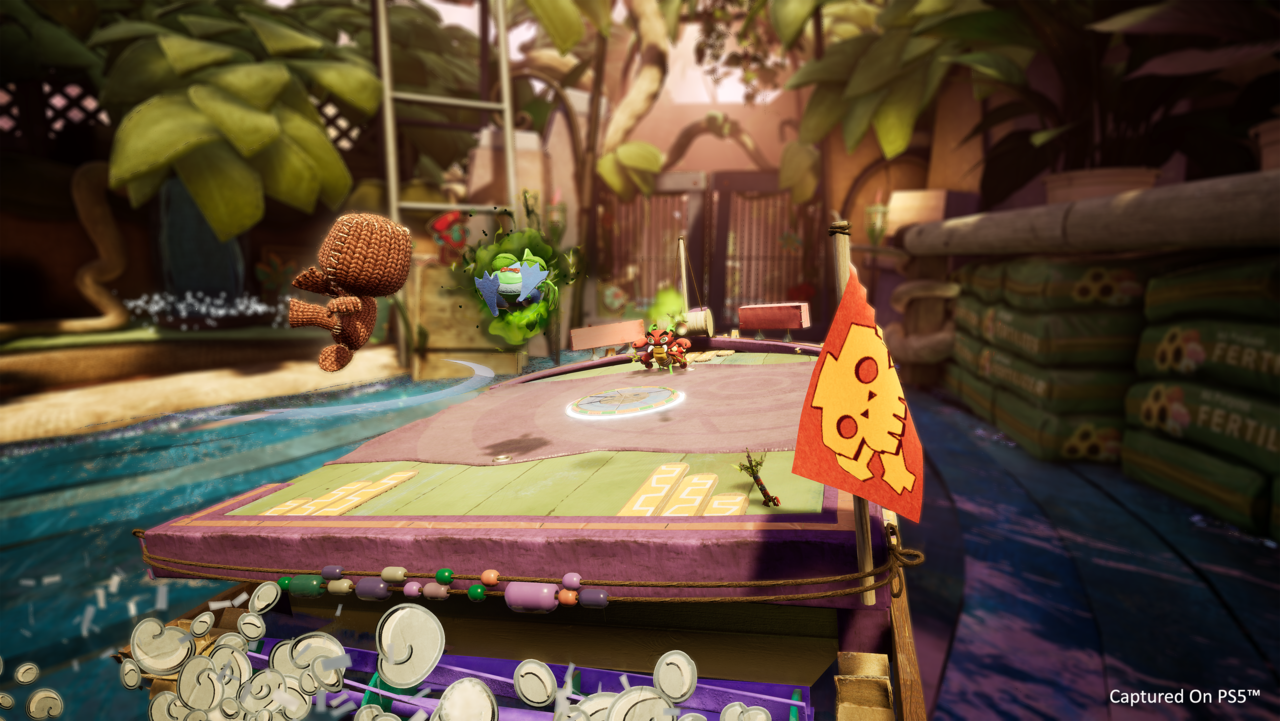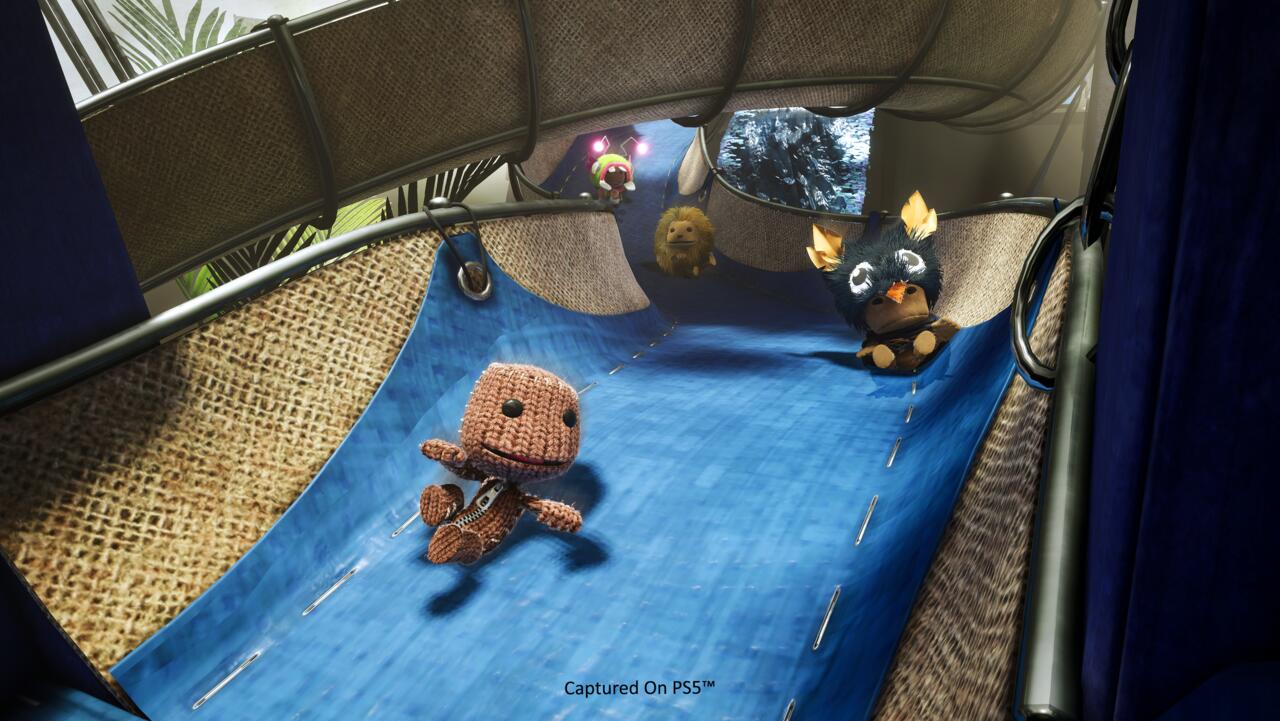In more than one way, Sackboy's Big Adventure is one of the PS5 showpieces. Aside from taking the adorable mascot and placing him in a new subgenre, the PS5 launch title (also available on PS4) is taking advantage of some of the new system's marquee features. From DualSense functionality (that makes use of the controller's haptics) to utilizing the PS5 UI and Activity system, Sackboy has a lot of weight on his tiny, fuzzy shoulders when it comes to advertising what Sony's next-gen console can do.
He's under a lot of pressure inside the in-game world too. Sackboy's Big Adventure begins when the villainous Vex descends on the peaceful village of Craftworld and kidnaps all of Sackboy's fellow sack-folk. Vex plans to use their Sack-labor to build a machine called the Topsy Turner, which will recreate Craftworld in his own image. So off Sackboy goes, armed with nothing more than pluck, yarn, and a few new moves.
GameSpot spoke with creative director Ned Waterhouse about bringing Sackboy into this new platforming subgenre, balancing challenge and accessibility, and how the team is making sure everyone can play together.

Sackboy is known for the LittleBigPlanet games. What made you develop a traditional 3D platformer as opposed to another LittleBigPlanet or something up that alley?
Waterhouse: As a team, we're massive LittleBigPlanet fans, and we are massive Sackboy fans. We're also huge fans of platformers. And when we started making this game, we said that we wanted to take this incredibly endearing character and make the best 3D co-op platformer we could. And that meant great character controls, a really rich and highly interactive world, loads of variety in the gameplay, and layering this really sort of joyful, slightly mischievous co-op experience on top. And so that was really our drive. It was to focus on play and to make the best 3D core platformer that we could.
You obviously imported some of the pieces of LittleBigPlanet. You got the satisfying little pop of the bubbles. What went into deciding which pieces to import into this new format and which pieces you could safely drop?
We said when we were going to make this game that it had to have LittleBigPlanet in its DNA. For us, I suppose the primary thing is that unique aesthetic, that handcrafted world, and that should also include some of those signature gameplay elements that [players] relate to--the prize bubbles, the score bubbles, the scoreboards, those sound effects, the bounce pads. So all of those signature gameplay elements should be present. But we wanted to go a bit deeper than that.
We wanted to make sure Sackboy is a massive fan of playing dress-up. So we wanted to bring in the costume system, make sure that you could really customize this Sackboy, your Sackboy, make him your own. So we've got over 60 costumes in the game. Like the previous games, they can all be mixed and matched to create your own bespoke costumes. You can color tint those, and that will enable you to create a Sackboy that's very much yours.
We wanted to make sure that this world and this story was full of quirky characters, that it had that sense of sort of British humor, slightly irreverent. And also, I guess the final thing, which was hugely important for us, was the soundtrack and what we do with music. And LittleBigPlanet has always been synonymous with these really eclectic and sometimes surprising soundtracks. And we picked up that ball with this game, and we have run with it. And we hope that players are going to be really pleasantly surprised by the music in this game.
How did you expand Sackboy's move set to fit the 3D platformer genre?
The sentiment that we had when creating this character was we wanted a character that was really responsive. So we said straight away that we're committing to 60 frames per second. And we wanted the character to feel fluid and expressive. And to make a character expressive, you need lots of options. You need lots of different ways of controlling him. And to make him fluid, you need to be able to chain all of these moves together. And coupled with that, we wanted to make something that was really easy to pick up and play, but had depth and nuance. So if you wanted to master this character, then you were going to have to learn about him, spend time with him and really affect your control of that character.
And so that's where we started. We expanded his move set to give us different options in terms of traversal, in terms of combat, in terms of puzzle-solving. There was some stuff that was originally power-ups, and we said, "This is so much fun, we're just going to make it a core part of his move set." And to give you an example of that, in the game there's a multiplayer move. You can pick up and throw each other. That was originally a power-up that we prototyped, and we said it's too much fun not to be able to pick up and chuck friends everywhere. Let's just put it in as part of his core move set and do away with the power-ups.
How are you balancing making this approachable for a young audience that'll probably be attracted to it while also still feeling like engaging for more experienced gamers?
We wanted to create a game which was really welcoming, that lots of people could enjoy. And so the game starts off very welcoming, and the challenge increases as you become more familiar with the character, which is to a lesser or greater extent what you would expect. But we said that although there is challenge and it does build up through this adventure, you should be able to complete this game--the main campaign--only using a subset of his moves. While there is challenge there and you do have to react quickly, you don't necessarily need to have gained mastery of the character in terms of which moves flow into each other best, how to affect speed runs, and that sort of thing, the sort of more advanced combos.
But we said that for those players that do master the character, if you want to discover all of the secrets, you want to set the highest scores, you want to beat all of the content, including the optional, more challenging stuff, then you really have to gain mastery of this character.
We have a set of optional side levels in the game called the Knitted Knight Trials. When Sackboy sets off on his quest, he sets off to become a Knitted Knight. The Knitted Knights are like the lost protectors of Craftworld. And he is mentored on his journey to becoming a Knitted Knight by a character called Scarlet. She is a kick-ass grandma with an eye patch. The Knitted Knight Trials are these quick-fire arcade-y challenges. They're essentially speed runs through really hazardous obstacle courses, where you have a single life. And that really tests players' understanding and mastery. The game's ultimate challenge is the final Knitted Knight Trial. And that's actually a 10-minute long trial where you have a single life. And I refer to that level as my Everest because to my embarrassment and the despair of the game design team, I still haven't finished it.
Everyone's going to get something from this game. There is a challenge as you progress through it, but you don't have to completely master the character. But if you are a real hardcore fan of the platforming genre, there's something here for you, too. We have post-game content. We have optional side content. We have a scoring system, which will challenge you to really master this character.

Do you have accessibility tools as well as options that will allow players of different skill levels to play together?
We really wanted to create an experience that as many people as possible could enjoy. So we support full remapping of the controllers so you can rebind any of the actions to any of the other options on the pads. We have a color blind mode in the game. We have a bunch of assists for players of different skill levels playing together. When we thought about those assists, it was very much about parents being able to play with young kids. And then we used and tested it and realized it was about kids being able to play with less able parents. We have a shared life system in the game, and that's really there to encourage collaboration and cooperation, but we realize that not everyone wants that challenge, so if you want, you can turn on infinite lives.
But we also have something called the assist copter, which is where basically if there's a piece of gameplay that an individual player is struggling with, Sackboy can light a flare, and that calls in this [heli]copter, which will pick him up, and it will follow the lead player. So provided one player can get past the tough platforming section, everyone can go past.
You've mentioned that the DualSense will let you feel different fabric textures. How do you approach that kind of functionality?
I'll be honest. We argue about it a lot as a team. You can find yourself having these interesting conversations about, 'what does it feel like to jump on a balloon?' Which is not something that I always anticipated my career would lead me to, but anyway. How do you communicate texture? Sackboy has always been able to grab things made of sponge and drag them around. And you can still do that in this game. And we said that when you pull something across the surface, it should feel different based on the surface friction. So if you're pulling something across sort of like a glass plate versus pulling something across a wooden board, the haptics should simulate the surface friction. And that comes through in the haptics. You essentially start with imagining what it would sound like, and that's a good start point for what it feels like. But also it needs to be reinforced with what you're seeing and what you're hearing from the game, because ultimately that level of immersion, that level of feedback is a combination of the visuals, the audio, and then what you're feeling through the controller. So the best sort of feedback events are where you get this really good synergy between what you're seeing on screen, what your ears are telling you, and what you can feel in your hands.
So you start with the sound, and then it's zeroing in on the feel until you sort of tweak it enough that it seems intuitively right?
Yeah, and also making sure that it reinforces what you're seeing, because essentially we consider the controller to be an extension of Sackboy. It's like your connection to him. So you need to think about what forces are acting on him and how that would feel to him to either be subject to or to impart those forces.
Sackboy's Big Adventure was used as sort of the showpiece for the PS5 UI, and particularly this new Activity system. How do you choose what parts of the game to highlight? And how do you implement that into your workflow?
When we began implementing the feature, the design was in place. So it was very much about interpreting the feature for our game. One of the primary benefits of it, in the context of our game, to be clear, is for completionists. Platform games have a rich history of secrets and discovery, and we've continued that tradition. So when you're trying to hunt for everything, you may get stuck and feel like you need that extra bit of help. The Activity system is a really nice way of creating that sort of completionist checklist. But also with the addition of the game help, if you're really stuck and there's just this one piece of information you need, you can get it, and it's at your fingertips. And that's just been a really nice sort of value-add to our game.

The Guide system seems like a lot of work. How many do you have? Did you select ones that you thought were particularly tricky?
No. We do everything. So yeah, it's work, but also I think the important thing here is that it's a real benefit to players because the system keeps you in the game. It keeps you in the moment. It keeps your momentum. And along with the SSD and so on and the fast load. It respects your time. Your time is valuable as a gamer, and these tools acknowledge that.
The PS5 version is taking advantage of all these new features that we talked about. Were there any other elements that are only included in the PS5 version? Were you limited by doing both at the same time?
We've put a lot of effort into the PS4 version, and we're really pleased with how that's turned out. It is a fantastic game in its own right. It was really important for us to be on PS4 because we want as many people to have an opportunity to play this game as possible.
That said, obviously the PS5 is a more powerful platform. It's got a bunch of new features. And so we were able to use these features to create an enhanced experience. So we've got greater graphical fidelity on the PS5. We've got the SSD, which basically facilitates near instantaneous loading between levels. It takes just a few seconds to jump in and out of levels, which it's fun. It's great. We've got the DualSense that we touched on that gives you this extra layer of immersion, we've got the 3D audio system on top of that, which again, adds to that immersion, and then the Activity system and the game help on top of that. So I guess what I'm trying to say is it's allowed us to take what is already a great game on PS4 and enhance it for this new platform.
We also wanted to make sure that everyone gets an opportunity to play this game in multiplayer. So we support PS4 and PS5 cross-play. If you have friends who haven't upgraded to a PS5 yet and you want to play online, you can.

